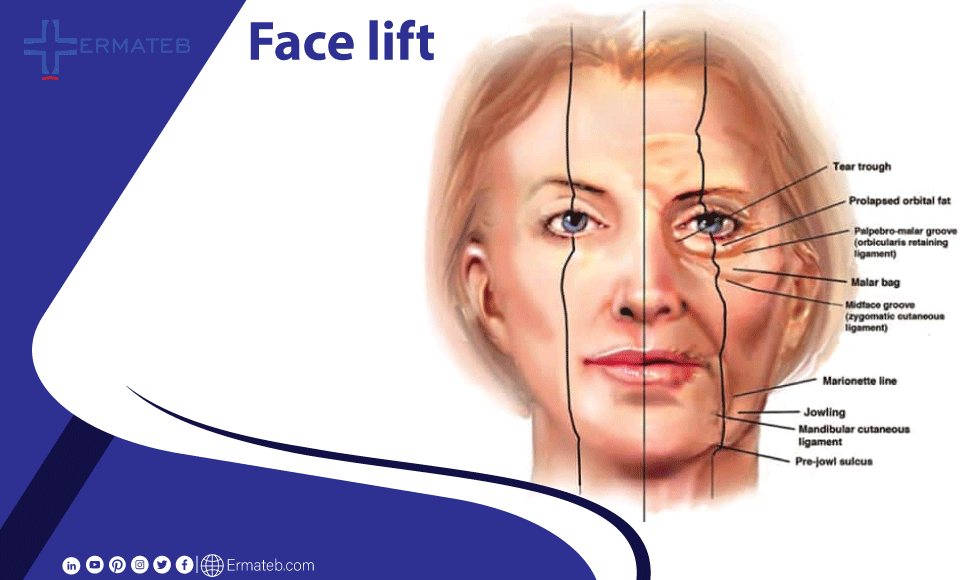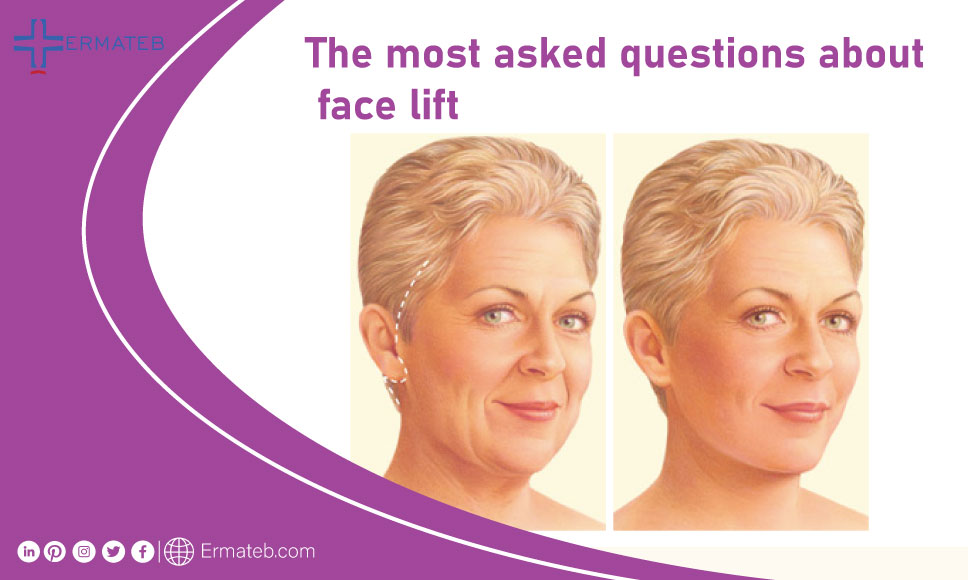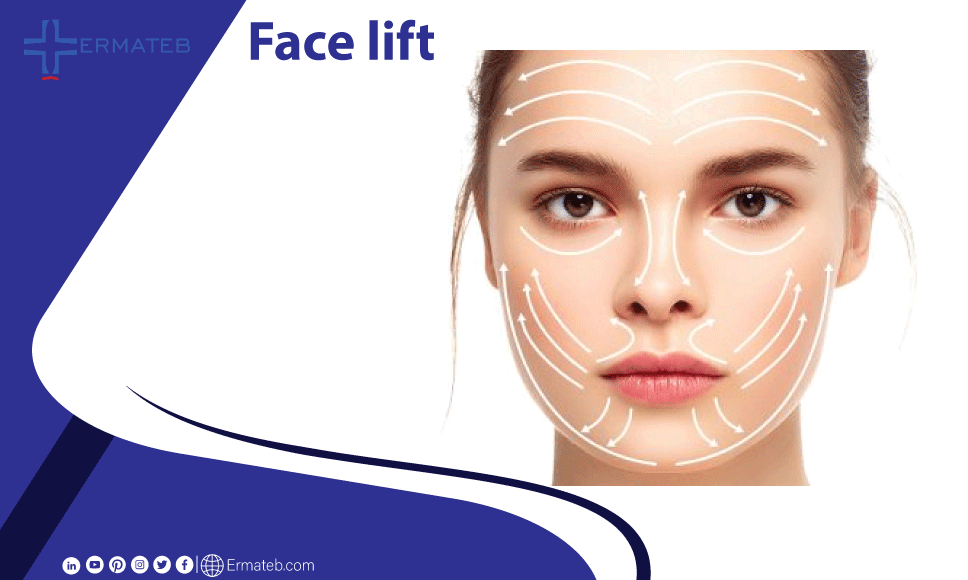
Facial lift (rhytidectomy) is a cosmetic surgery to soften and smooth the skin by lifting and pulling it back.
This method is designed to reduce loose or sagging skin around the lower half of the face (mainly the neck) and neck.
If you decide to do this cosmetic operation, this article will answer many of your questions about it.

The preparation steps are as follows:
1. Medical history and examination:
Information including complications of previous surgeries, past and current medical conditions, previous surgeries, previous plastic surgeries, history of smoking, and drug or alcohol use will be received from you by the relevant doctor and specialists. You will have a physical examination by a surgeon, your doctor may ask your doctor for recent history, or he or she may consult a specialist if you have any concerns about your ability to have surgery.
2. Medication Review:
Provide your doctor with information such as name and dose about all medications you take regularly, including prescription drugs, over-the-counter medications, herbal remedies, vitamins, and other dietary supplements.
3. Facial examination:
The plastic surgeon takes photos of your face from different angles, and the surgeon also examines your face shape and bone structure, fat distribution, and skin quality to select the best option for the facelift.
Expectations: The specialist will ask questions about your expectations of the results of the facelift. It talks to you and helps you understand how a facelift will change your appearance and what it will not do.
Follow medication instructions: Follow and follow instructions on what medications to take and when to stop. For example, you may be asked to take diluents or supplements. Cut the blood at least two weeks before surgery. Also, talk to your doctor about what medications are safe to take or what specific doses of the medication can be taken.
Wash your face and hair. You will most likely be asked to wash your hair and face with germicidal soap on the morning of surgery.
Avoid eating: Avoid eating anything after midnight before a facelift, and you can only drink water and take medications approved by your surgeon.
Get help during recovery: If your facelift is done on an outpatient basis, arrange with someone to take you home after surgery and stay with you the first night
after surgery.

In general, facial lifts involve lifting the skin and tightening the underlying tissues and muscles. Fat on the face and neck may be shaved, removed, or redistributed. The facial skin is then repositioned on the lines that have been repositioned, the excess skin is removed, and the wound is sutured or bandaged.
Surgery usually takes two to four hours, but it may take longer if other cosmetic procedures are performed at the same time.
Incisions for this procedure depend on the techniques used and the patient's preferences. Options are:
A traditional facelift incision:
This incision starts at the temples in the hairline and continues down and around the front of the corners and ends behind the corners at the bottom of the scalp. Your doctor may make an incision under your chin to improve the appearance of your neck.
A limited incision:
A shorter incision that starts at the hairline just above the ear, wraps in front of the ear but does not extend to the end of the scalp.
Neck lift incision: continues from the front of the earlobe to around the ear to the bottom of the scalp. A small incision is also made under the chin.
What will the condition be like after the operation?
After a facelift, you may experience:
Mild to moderate pain
Drainage from the incisions
Bruising
Inflation
numb
Contact your doctor immediately if you have any of the following:
Severe pain in one side of the face or neck within 24 hours after surgery
Irregular heartbeat
Shortness of breath
Chest pain
The specialist will probably cover your incisions with bandages to apply gentle pressure to minimize swelling and bruising. A small tube may be placed under the skin behind one or both of your ears to drain excess blood or fluid.
In the first few days after surgery:
Rest your head up
To relieve pain and reduce swelling, apply cool packs on the face
Take painkillers as recommended by your doctor

After the facelift, a bandage may be placed around your face to minimize swelling and bruising, and small tubes may be placed to remove excess blood or fluid.
Follow the specific instructions that will be given to you on how to care for the surgical site and drains, medications that should be applied or taken orally. You will also be given an appointment with a plastic surgeon.
Be sure to ask your plastic surgeon questions about the length of your recovery period. For example:
1. Where will I be transferred after the surgery?
2. What medication will I be given or prescribed after surgery?
3. Will I have a dressing after surgery?
4. When will they be removed?
5. When are the stitches removed?
6. When can I wash my face and apply makeup?
7. When can I resume normal activity and exercise?
8. When can I dye or cut my hair?
Here are some tips to help you get started:
1. Complete recovery after a facelift takes about 2 to 4 weeks.
2. Bruising is visible for at least 2 weeks. It may take 6 to 9 months for the full effect of the facelift to be seen.
3. The surgeon will advise you not to drive for several days after the operation.
4. Avoid showering and getting the bandage wet for the first 2 days, and avoid strenuous activity, saunas, and massages for at least 2 weeks.
5. Also, keep your head with a pillow for a few days to reduce swelling.
6. Stitches are removed after about a week (unless the stitches are soluble)
7. After a few weeks, the scar, bruise, the redness should disappear.
8. After 6 to 9 months, the final result of the facelift will appear.
A face lift can make your face and neck look younger and more beautiful.
It takes 2 to 3 months for the face to feel normal again in terms of sensitivity, texture, and loss of firmness.
Having a healthy lifestyle and continuing daily sun protection can increase the results of a facelift.
As the swelling and bruising decrease, a visible improvement in the facelift appears. The result will both make you look younger and more attractive and boost your self-confidence towards your appearance.
You will see good results after this surgery, but like any other surgery, it is not possible to guarantee that in some cases, the desired results may not be achieved with one surgery, and another surgery may be necessary.
If you follow your doctor's instructions well, the chances of good results are higher.
It should be noted that the results of facelifts are not permanent and aging may cause the skin of the face to sag. The results of facelifts usually take 10 years.

Facelift costs include the cost of anesthesia, operating room facilities, or other related costs in addition to the total price. Please consult your plastic surgeon's office to determine your final cost.
Facelift costs may include the following:
Surgeon's fee
Hospital or surgery center costs
Anesthesia costs
Pharmaceutical prescriptions
Clothes after surgery
Medical tests
This cost also depends on the surgeon's salary based on his experience, the type of method used, and the geographical location of the office.
Most health lift surgery insurance plans do not cover the face or its side effects.

